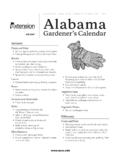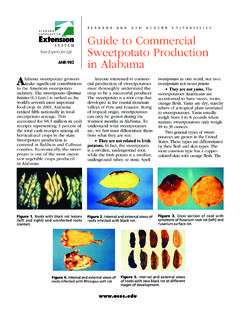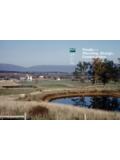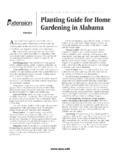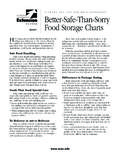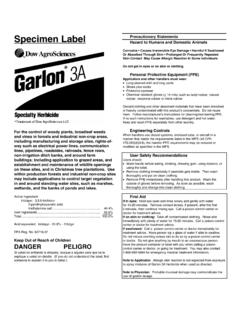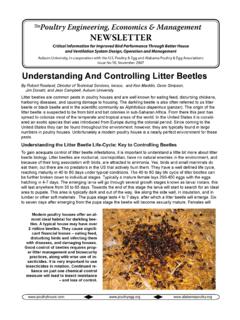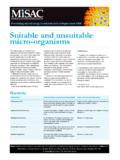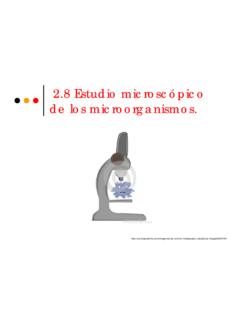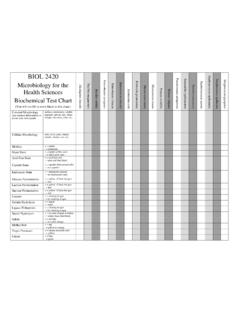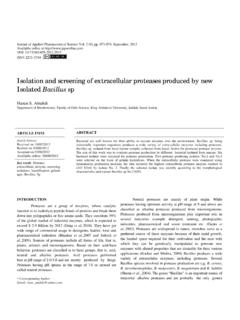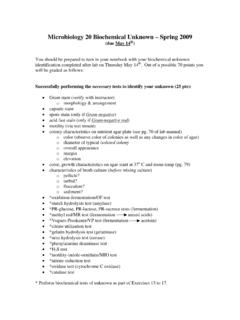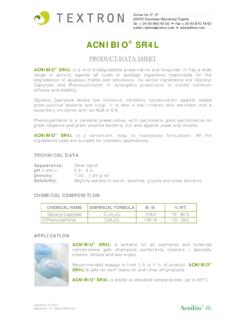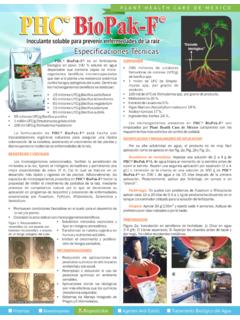Transcription of VI Prebiotics and Probiotics: Definitions and …
1 SRAC Publication No. 4711. December 2012. VI. PR. Prebiotics and Probiotics: Definitions and Applications Delbert M. Gatlin III1 and Anjelica M. Peredo1. Infectious diseases cost the aquaculture industry mil- which are derived from various plants or cell wall compo- lions of dollars each year. Therefore, there is great interest nents of yeast. A commercial product that possesses pre- in developing alternatives to traditional means of combat- biotic properties is the yeast-based product GroBiotic -A, ing diseases with chemotherapeutics. Traditional disease which is a mixture of partially autolyzed brewers yeast, prevention and treatment strategies, such as the use of dairy ingredient components, and dried fermentation prod- vaccines and drugs, have limitations such as regulatory ucts.
2 The various prebiotic compounds are generally not constraints or inconvenient means of delivery. This has altered by diet processing and require limited regulatory heightened interest in the use of dietary additives that may approval, making their use much simpler than using drugs influence the immunity and disease resistance of aquatic or chemical therapeutic agents. The benefits of Prebiotics species. Although the concept of functional feeds is rela- are described below and summarized in Table 1. tively new to the aquaculture industry, there is promise in developing diets that do not just satisfy minimum nutri- tional requirements but also improve health and resistance Probiotics to stress and disease-causing organisms.
3 Two types of feed The term probiotic was defined by Parker (1974) as additives that have been investigated with terrestrial and organisms and substances which contribute to intestinal aquatic organisms are those which influence the micro- microbial balance. Fuller (1989) revised the definition biota of the gastrointestinal tract (GIT). The additives are as live microbial feed supplement which beneficially broadly grouped as Prebiotics and probiotics. affects the host animal by improving its intestinal micro- bial balance. Subsequently, Moriarty (1998) proposed that the definition of probiotics be extended to microbial Prebiotics water additives.
4 Administering probiotics in water has Prebiotics are defined as non-digestible food ingre- been shown to improve water quality by reducing the dients that selectively stimulate the growth and/or the concentrations of nitrogen and phosphorus (Wang et metabolism of health-promoting bacteria in the intestinal al., 2005). Probiotics administered in water or diet also tract, thus improving an organism's intestinal balance (Gib- may inhibit the growth of pathogenic microorganisms, son and Roberfroid, 1995). The health-promoting bacteria contribute digestive enzymes to increase feed utilization, most commonly augmented by Prebiotics include those provide other growth-promoting factors, and stimulate of the genus Lactobacillus and Bifidobacter, which tend to the immune response of the organism.
5 Limit the presence of harmful bacteria. Examples of pre- Recognized probiotics that may influence fish immu- biotics include mannanoligosaccharides, lactose, galacto- nity, disease resistance, and other performance indices gluco-mannans, oligofructose, and inulin. Many of these include those of the genus bacillus and various lactic acid Prebiotics are carbohydrates, primarily short-chain oligo- bacteria (Lactobacillus, Lactococcus, Carnobacterium, saccharides consisting of three to ten carbohydrate units, Pediococcus, Enterococcus and Streptococcus). Bacteria of the genus bacillus are Gram-positive rods that form Department of Wildlife and Fisheries Sciences, Texas A&M University 1.
6 Spores that are resistant to various environmental condi- tions and thus have extended shelf life. bacillus subtillis, shown some degree of success (Merrifield et al., 2010). B. licheniformis, B. circulans, B. coagulans, B. clausii, The logistical constraint of culturing live microorganisms and B. megaterium all have been used as probiotics. under controlled laboratory conditions before applying Lactobacillus rhamnosus, L. delbr eckii, Carnobacterium them to the feed has constrained the use of probiotics at maltaromaticum, C. divergens, C. inhibens, and Entero- aquaculture facilities; thus, administering lyophilized coccus faecium are other bacteria that have been used as cells or spores may be more practical.
7 Potential applica- probiotics, along with yeasts such as Candida sake and tions of probiotics in fish, shrimp and molluscan aquacul- Saccharomyces cerevisiae. The bacteria must remain viable ture have been reviewed by Burr et al. (2005), Wang et al. during storage and processing for probiotics to confer (2008), Kesarcodi-Watson et al. (2008), and most recently their beneficial effects, but the application of dead cells, by Ring et al. (2010a). freeze-dried cells, or cell-free extracts or spores have all Table 1. Summary of Prebiotics evaluated in aquaculture (adapted from Ring et al., 2010b). Prebiotica Dose (g kg-1); Species Initial Responseb Reference duration of trial weight (g).
8 Inulin 150; 4 weeks Arctic charr 218 Intestinal cell damage Olsen et al. (2001). (Salvelinus alpines). 75; 3 weeks Atlantic salmon 172 Intestinal cell damage; Refstie et al. (2006). (Salmo salar) Intestinal growth and relative mass of the gastrointestinal tract 5 and 10; 1 week Gilthead seabream 175 Significant inhibition of Cerezuela et al. (Sparus aurata) phagocytosis and respiratory (2008). burst in leucocytes 20; 1 month Turbot larvae n/a Growth rate; Effects on gut Mahious et al. (Psetta maxima) microbiota ( bacillus and Vibrio) (2006). MOS 10; 4 months Atlantic salmon 200 Oxygen consumption; Grisdale-Helland Protein and energy et al. (2008).
9 Concentration in the whole body 2; 4 weeks Channel catfish Growth performance, Welker et al. (2007). (Ictalurus hematology, or immune punctatus) function 20 and 40; 67 days European sea bass Weight gain (WG); Torrecillas et al. (Dicentrarchus Feed efficiency (FE); (2007). labrax) Lipid vacuolization;. Presence of Vibrio alginolyticus in head kidney 2; 90 days Rainbow trout WG and survival; Staykov et al. (Oncorhynchus Antibody titer and lysozyme (2007). mykiss) activity ; 43 days White seabream n/a Microvilli length Dimitroglou et al. larvae (Diplodous (2010). sargus). 0 and 4; 12 weeks Rainbow trout WG; Hemolytic and Rodrigues-Estrada phagocytic activity; Mucus et al.
10 (2008). weight; Survival against Vibrio anguillarum 2 Prebiotica Dose (g kg-1); Species Initial Responseb Reference duration of trial weight (g). MOS 0, 2 and 6; 58 days Hybrid tilapia WG; Survival; He et al. (2003). (continued) (Oreochromis Non-specific immunity niloticus O. aureus). 10; 4 weeks Red drum FE; Survival following Buentello et al. (Sciaenops parasitic challenge; (2010). ocellatus) Non-specific immunity FOS 10; 4 months Atlantic salmon 200 Feed intake, WG or Grisdale-Helland digestibility et al. (2008). 10; 4 weeks Red drum Non-specific immunity Buentello et al. (2010). 0, 2 and 6; 58 days Hybrid tilapia WG; Survival; He et al. (2003).
